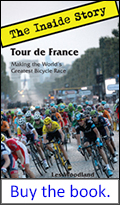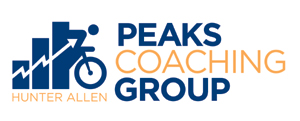

Three Common Racing Mistakes and How to Fix Them
By Tim Cusick, PCG President and Elite Coach
Back to list of our training and coaching essays

Les Woodland's book Tour de France: The Inside Story - Making the World's Greatest Bicycle Race is available as an audiobook here. For the print and Kindle eBook versions, just click on the Amazon loink on the right.
Tim Cusick writes:
One of my favorite (and most frustrating) things about racing is how hard it is to win. There are very few sports that rank with cycling in terms of all the things that must align to capture that elusive victory. As a professional coach, I have the luxury of replaying hundreds of races through my clients’ eyes and have learned that there are a few common mistakes repeated time and time again as riders learn to race. I’d like to share with you my solutions to three of these mistakes.
MISTAKE 1: THE HERO MOVE
You know this move. It’s the moment when you rip open the zippered lycra of your cycling jersey to reveal the large capital yellow S on your chest and unfurl your streaming red cape, attacking and dropping your competition from 50k out, then effortlessly holding them off to the finish. What a rush! Unfortunately this move often looks different in real life, more like throwing down a 1,000-watt attack, opening a gap, holding it for 3-5 minutes, then getting caught by the pack and hanging on or even getting spit out the back. The hero move is many times a ticket to disaster, often ensuring a pack finish at best.
Some Suggestions
Bike racing is all about understanding the odds. With all the things that have to go right, you’ve got to learn patience and begin to think about the odds. I teach my clients the “Rule of 3” as they learn to race;
Step 1: Narrow the odds.
Step 2: Narrow the odds.
Step 3: Win the race.
This means learning to think through the race to go for the win. Your first two moves (I target two simply as an example; it might be one, it might be five, but focus on the idea) are ways to improve your odds of winning. How can you whittle down the pack? Get rid of the riders on the edge. Shell your key competitor. This is accomplished by smaller moves, often in conjunction with other riders. How can your moves narrow the odds? Here are some ideas:
A. Don’t go it alone! In a pack of fifty riders, your early move should be focused on splitting the pack in half or at least reducing the count. How? Don’t attack so hard that other riders aren’t willing to follow (or believe you’ll just blow up the road); attack hard but bring a bunch. How do you bring others? Here’s a simple answer many racers don’t think of: try telling others before you attack. That’s right; give away your super-secret strategy (which most of the other racers are already thinking about, by the way) and tell a small group of select riders that you think have the horsepower to attack, then see if they’ll work with you for a while to at least drop a percentage of the pack.
B. Once you’ve dropped off a chunk of the pack, focus on ways to set up the next separation. Now is the time to start thinking about how you can win the race and then do something to set that up. Are you planning on the sprint finish? Are you a killer TT artist looking for the longer break? Your second narrow-the-odds move needs to start setting up your winning move.
C. Your winning move is your strength (or at least that’s how the plan should go). Bike racing often forces you to improvise as you go, but focus on setting up final moves that allow to implement your strength as the move.
MISTAKE 2: OVER-FOCUS ON THE COURSE AND NOT THE OTHER RACERS
In any mass start event you’re affected by the terrain, but you race other racers. Too many people who start racing over-focus on the course and its terrain and layout and forget to pay attention to other riders.
Some Suggestions
Observe others on the course and on terrain to better understand how they ride, how tired they are, how they can beat you, and how you can beat them. Here are a few tricks:
1. Look at the other riders. How do they look? Have they been drinking and eating? Look at their bikes. Are their water bottles full?
2. Look around on short climbs later in the race. Many riders really show fatigue on short climbs later in races. Look to see who’s really suffering and who’s not, then use this knowledge to improve your odds. If you’re strong but watching a good percentage of the group suffering, talk to some of the other riders going well and plan a strong push on the next riser to get rid of the suffering riders.
MISTAKE 3: ATTACK WHEN THINGS ARE EASY
Okay, a lot of people might know this one, but I can’t tell you the numbers of times I’ve reviewed files from smart racers who get impatient and attack when things are easy and cruising along. The reality is that if things are just cruising down the road, everyone is ready to attack (and counter). Typically this means they’ve caught their breath and will be quick to respond and chase.
Some Suggestions
Learn to attack when things are hard. This is a big key to success. I know it hurts, but suck it up, buttercup. This is bike racing; if you want to win, it’s going to hurt. When things are going hard and you attack or make a move, many riders sit back hoping others will do the work to chase you as they do an internal gut-check on how demoralizing that flyer you just took was. This doesn’t mean that catching everyone sitting up for a second and throwing down a little surprise can’t work, but it’s much better to hit them when it hurts.
There are plenty of ways to use these tips. My goal is to point out some key areas of mistakes and give you food for thought. Obviously, you need to be fit enough to handle the demands of the race event and implement your strategy to win. Best of luck to you!
.








